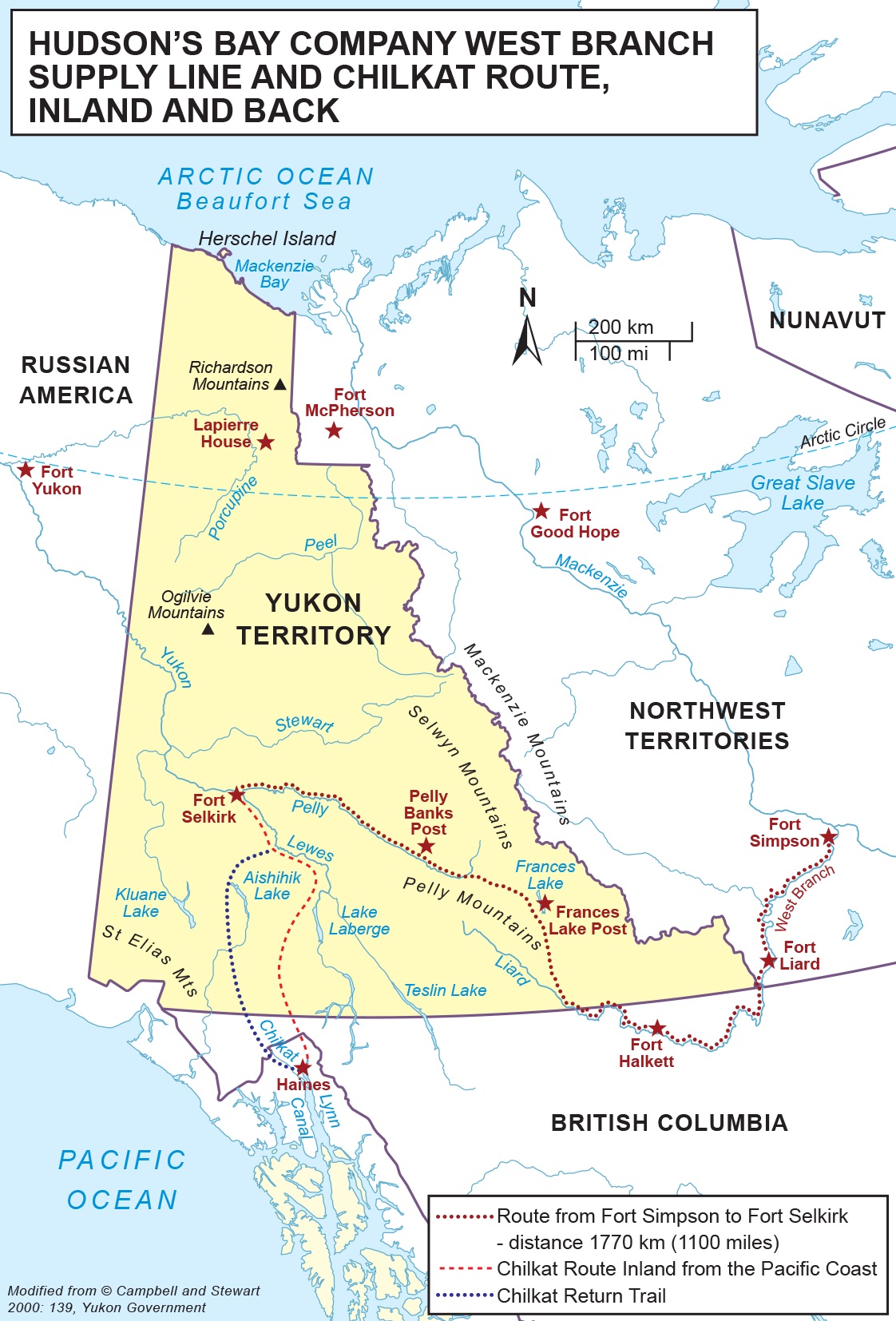Chapter 4 – Yukon First Nations’ Relationship with Newcomers
Yukon Indigenous Populations
Population estimates for Indigenous peoples in Yukon prior to direct contact with newcomers range from 4,700 (Kroeber 1939:141–142) to 9,100 (Krech 1978) or more (McClellan and Denniston 1981:372). Indirect contact with newcomers first occurred during the eighteenth century when Russian (c. 1771), Spanish (c. 1774), and English (c. 1778) traders arrived on the coast of Alaska (Gibson 1992:12, 18, 22), to the west of Yukon. One of the first contact events between newcomers and Indigenous peoples living close to the eastern Yukon border occurred in 1789, when fur trader Alexander Mackenzie[1] began trading with the eastern Gwich’in people of what is today the Mackenzie River drainage basin (Slobodin 1981:528) (Figure 4.1).
Although these non-Indigenous traders had no direct contact with people within the borders of Yukon, their trade activities on the coast and east of Yukon eventually brought disease to coastal Pacific and Mackenzie River people, who in turn spread diseases into Yukon during their Indigenous trade expeditions (Slobodin 1981:529). Once direct newcomer and Indigenous contact took place, diseases such as scarlet fever, smallpox, mumps, measles, dysentery, jaundice, whooping cough, pneumonia, diphtheria, meningitis, and influenza devastated Indigenous populations (Coates 1991:13; Helm et al. 1971:329-337; Legros 2007:115–123; Marchand 1943; Northern Native Broadcasting Yukon 1988b). By 1890, when traders, missionaries, and miners had made their mark within the territory, it is estimated that there was significant Indigenous population loss because of European diseases (Legros 2007:123). Indigenous peoples had little or no immunity to these new diseases, which could wipe out an entire community in a number of weeks (Anderson to Council, HBCA B/200/b/28: 55 [Nov. 30, 1852]; Campbell 1958:109 [May 30, 1851]; Campbell and Stewart 2000:102 [May 20, 1851]; Dawson 1987 [1887]:138B; Fortuine 1989:116). Disease destroyed families, often causing the death of knowledge-bearing Elders and the loss of family leaders, such as mothers and fathers. No one was left unaffected (Radford et al. 2005). Some people had to move to live with other family members or other Indigenous groups to survive; others were forced to stop living on the land, and instead became more sedentary.[2] This caused many people and communities to lose their traditional systems of kinship and cultural knowledge, as well as languages, as they amalgamated with other families and groups.

Population numbers began to rise once again during the early twentieth century, with a total Yukon population of 27,000 people in 1900, 3,300 estimated of whom were Indigenous. Due to the post–gold rush exodus, by 1911 Yukon’s population declined to 6,000, including 1,500 Indigenous people. By the 1920s, the population of Yukon had dropped to 4,000, including 1,500 Indigenous people (Canada 2009a:951). This number held steady until the early 1940s, when Yukon’s population climbed once again, to 38,000 people, although the Indigenous population remained at 1,500 (Canada 2009b:155). By the 1960s, Yukon’s Indigenous population was estimated to be approximately 3,000 people (Jonason et al. 1960:2). In 1996, the total population of self-identified Indigenous people within Yukon totalled 6,170 (Government of Yukon 1998), and by 2011 it was 7,710, or 23.1 percent of Yukon’s population (Government of Yukon 2014). The 2011 National Household Survey census indicates that the number of people self-identifying as Indigenous is 7,710 (Government of Yukon 2014:1-12).
- Alexander Mackenzie worked for the Northwest Fur Company (NWC). The NWC and the Hudson’s Bay Company were the primary fur traders in Rupert’s Land (which later became Canada) until their merger in 1821. ↵
- The term sedentary is defined as the transition from a nomadic lifestyle, in which people move from camp to camp at regular intervals, to a society in which one remains in one place permanently, in a single settlement. ↵

